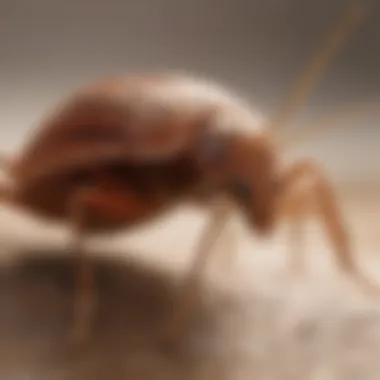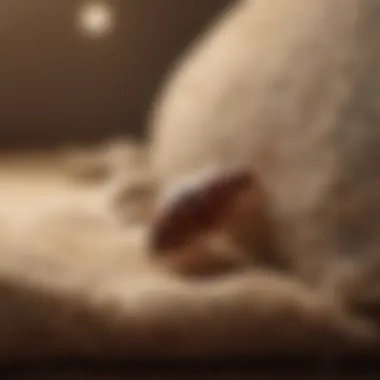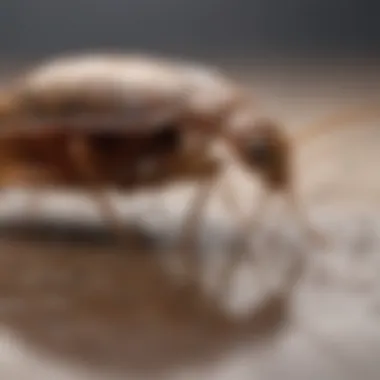Unraveling the Enigmatic Universe of Bed Bugs: A Comprehensive Exploration


Animal Species Profile
Bed bugs, scientifically known as Cimex lectularius, belong to the family Cimicidae, comprising small, parasitic insects that primarily feed on human blood. These nocturnal creatures measure about 4 to 5 millimeters in length, sporting a reddish-brown color and flat oval-shaped bodies. Natural habitat-wise, bed bugs gravitate towards warm environments close to their hosts, infesting beds, furniture, and cracks in walls. Behaviorally, bed bugs exhibit secretive behavior during the day and emerge at night to feed on their unsuspecting hosts. They communicate through pheromones to locate potential feeding grounds and reproduce. Being highly reproductive, one female bed bug can lay hundreds of eggs in a lifetime, contributing to rapid infestations if left unchecked in human dwellings.
Introduction
In the vast landscape of entomology, a particularly intriguing species that captures the interest of researchers and enthusiasts alike is the bed bug. These tiny blood-feeding insects, scientifically known as Cimex lectularius, have long coexisted with humans, leaving a trail of fascination and discomfort in their wake. Understanding the nuances of bed bugs is not only essential for effective pest control but also sheds light on a lesser-explored aspect of the natural world.
Defining Bed Bugs
Understanding the taxonomy of bed bugs
Exploring the taxonomy of bed bugs delves into their scientific classification and evolutionary history. This crucial aspect allows researchers to grasp the genetic relationships between different bed bug species and understand their ecological role. By investigating their taxonomy, we can unravel the intricate web of biodiversity and evolution that surrounds these elusive creatures. The unique feature of taxonomy lies in its ability to provide a structured framework for organizing bed bug diversity, aiding in species identification and conservation efforts.
Historical references to bed bugs
Tracing back through history, bed bugs have left an indelible mark on human civilization. References to bed bugs date back centuries, appearing in ancient texts and folklore as notorious pests that plagued societies. By exploring these historical references, we can gain insight into the cultural perceptions of bed bugs and track the evolution of human-bed bug interactions over time. This historical lens not only enriches our understanding of bed bugs but also highlights the enduring impact they have had on human settlements.
Importance of Studying Bed Bugs
Impact on human health
The impact of bed bugs on human health extends beyond physical discomfort, with implications for mental well-being and quality of life. Understanding the health aspects related to bed bug infestations is paramount in mitigating risks and developing effective control strategies. By delving into the consequences of bed bug bites and associated health issues, we can better safeguard public health and enhance living conditions.
Economic implications of infestations
The economic repercussions of bed bug infestations reverberate across diverse sectors, including healthcare, hospitality, and housing. The costs incurred due to infestations, ranging from treatment expenses to revenue losses, underscore the financial burden imposed by these pests. Investigating the economic dimensions of bed bug infestations unravels a complex interplay between pest management practices and economic sustainability, emphasizing the need for proactive pest control measures.
Overview of Bed Bug Infestation
Common hiding spots of bed bugs


Bed bugs are adept at concealing themselves in a variety of hiding spots, making detection and eradication a challenging task. Understanding their preferred hiding places, which include cracks, crevices, and furniture seams, is crucial for effective pest management. By shedding light on these common hiding spots, we can better equip individuals to identify potential infestation sites and implement targeted control measures.
Signs of a bed bug infestation
Recognizing the signs of a bed bug infestation is crucial for early intervention and prevention of widespread infestations. From characteristic bite marks on the skin to the presence of shed exoskeletons and fecal stains, each indicator offers valuable insights into the presence of bed bugs. By familiarizing oneself with these telltale signs, individuals can take prompt action to address infestations and safeguard their living environments.
Physical Characteristics of Bed Bugs
In the realm of bed bug studies, understanding the physical characteristics of these pesky insects holds immense significance. The physical attributes of bed bugs play a pivotal role in various aspects of infestation control and management strategies. By comprehensively grasping the appearance and morphology of bed bugs, researchers and pest control professionals can effectively identify, target, and eradicate these tiny yet resilient creatures. This section sheds light on the vital role that physical characteristics play in combating bed bug infestations and emphasizes the importance of meticulous observation and analysis.
Appearance and Morphology
Description of Adult Bed Bugs
Delving into the description of adult bed bugs unveils crucial details about the mature stages of these blood-feeding insects. Understanding the distinct physical features of adult bed bugs, such as their reddish-brown oval bodies and six legs, forms the foundation for accurate identification and differentiation from other household pests. The prominent hallmark of adult bed bugs is their flat, wingless structure, allowing them to adeptly conceal in cracks and crevices, waiting to feed on unsuspecting hosts. This comprehensive insight into adult bed bug morphology offers valuable information for researchers and individuals dealing with infestations, enabling prompt action and targeted treatment methods.
Identifying Features of Nymphs
Exploring the identifying features of nymphs, the juvenile counterparts of adult bed bugs, provides a deeper understanding of the insect's life cycle and development. Nymphs possess a translucent body that darkens after feeding, accompanied by smaller body size compared to adults. Their inability to reproduce until reaching maturity showcases a critical aspect of their life stage. Recognizing the unique characteristics of nymphs facilitates early detection of infestations and aids in implementing strategic intervention measures. This section accentuates the significance of differentiating nymphs from adults in devising effective control strategies and minimizing the spread of bed bugs.
Adaptations for Survival
Mastering the adaptations that enable bed bugs to survive in diverse environments is integral to combating infestations and preventing reoccurrence. Bed bugs exhibit remarkable resilience to varying conditions, including temperature fluctuations and limited food sources, owing to their adaptive physiology. By withstanding adverse environmental factors, bed bugs prolong their presence, making eradication a challenging task for homeowners and pest management professionals. Analyzing their feeding habits and preferences unravels insights into their survival mechanisms, highlighting the necessity for comprehensive control strategies that address their adaptive behaviors. Understanding how bed bugs thrive in different settings empowers individuals to proactively protect their living spaces and belongings from potential infestations.
Behavioral Patterns of Bed Bugs
In this segment of the article, we delve into the intricate world of the behavioral patterns of bed bugs. Understanding the behavior of these tiny creatures is crucial as it sheds light on their interactions with their environment and hosts. By examining their behavioral tendencies, we can glean insights into their survival strategies and feeding habits. The section aims to unravel the nocturnal lifestyle and feeding behavior of bed bugs, providing a comprehensive overview of their behavioral ecology.
Nocturnal Lifestyle
Exploring the nocturnal lifestyle of bed bugs reveals the fascinating activity patterns exhibited by these insects during the night. Bed bugs are primarily nocturnal creatures, preferring to feed and move around under the cover of darkness. This behavior is essential for their survival as it allows them to avoid detection by hosts and predators during their most active periods. Understanding the nocturnal lifestyle of bed bugs is vital in comprehending their biology and developing effective control strategies to manage infestations.


Activity patterns of bed bugs during the night
Focused on the activity patterns of bed bugs during the night, this section sheds light on how these pests navigate their surroundings and search for hosts. Bed bugs exhibit distinct activity peaks during the late hours, showing heightened movement and feeding behaviors. This nocturnal activity is crucial for their reproductive success and survival, highlighting the adaptation of bed bugs to their environment. Despite being a nuisance to humans, this behavior underscores the evolutionary success of bed bugs as resilient and adaptable organisms within their ecosystem.
Feeding Behavior
Delving into the feeding behavior of bed bugs uncovers the mechanisms through which these pests obtain their necessary nutrients for survival and reproduction. Understanding their feeding behavior is integral to developing effective management strategies and controlling infestations. By analyzing their feeding habits, we can garner insights into their preferences and the frequency of blood meals required for their development.
Process of feeding on hosts
This section explores the process of feeding on hosts, detailing how bed bugs locate, access, and feed on their preferred hosts. Bed bugs possess specialized mouthparts that enable them to pierce the skin and extract blood efficiently. Their feeding process is meticulous, involving specific behaviors geared towards maximizing blood intake while minimizing the risk of detection. By examining the intricacies of their feeding behavior, we can discern strategies to disrupt their feeding cycle and mitigate infestations effectively.
Frequency of blood meals
Examining the frequency of blood meals sheds light on the metabolic needs and reproductive cycles of bed bugs. These insects require regular blood meals to mature, reproduce, and sustain their population. The frequency of blood meals varies among bed bug species and life stages, influencing their growth rate and reproductive capacity. Understanding the factors that drive the frequency of blood meals is pivotal in formulating targeted interventions to combat infestations and reduce the nuisance caused by these persistent pests.
Health Implications of Bed Bug Bites
The crucial section discussing the Health Implications of Bed Bug Bites within the broader context of this enlightening article on bed bugs aims to shed light on the direct impact these tiny pests can have on human well-being. By focusing on the specific elements of health consequences caused by bed bug bites, readers will gain a deeper understanding of the importance of early detection and effective control measures. This section delves into the physical and psychological effects of bed bug bites, emphasizing the significance of promptly addressing infestations to prevent potential complications and protect personal health.
Physical Effects on Humans
Common reactions to bed bug bites
The detailed examination of the common reactions to bed bug bites offers valuable insights into the immediate effects experienced by individuals exposed to these blood-feeding insects. By highlighting the key characteristic reactions such as redness, itching, and swelling at the bite site, readers can recognize the tell-tale signs of bed bug presence in their surroundings. Understanding these common reactions is essential for timely intervention and treatment, underscoring the importance of proactive measures in controlling infestations and minimizing discomfort for affected individuals. Exploring the unique features of these reactions provides a holistic view of the impact bed bug bites can have on human health, guiding readers towards effective preventive strategies and swift responses to potential outbreaks.
Potential complications
Unveiling the potential complications arising from untreated bed bug bites brings to the forefront the long-term health risks associated with persistent infestations. By elucidating the key characteristic complications such as secondary skin infections and allergic reactions, this section underscores the urgency of addressing bed bug issues comprehensively. Recognizing the implications of these complications reinforces the need for comprehensive pest management practices, including professional extermination methods and proactive prevention strategies. Analyzing the advantages and disadvantages of various treatment approaches offers readers a well-rounded perspective on mitigating the health consequences of bed bug infestations, empowering them to safeguard their well-being and living environments more effectively.
Preventive Measures and Control Strategies


Preventive Measures and control strategies are paramount in the study of bed bugs, ensuring a proactive approach to tackling infestations. Understanding the significance of preventing these pests from infiltrating living spaces can save individuals from the discomfort and health risks associated with their presence. By implementing effective prevention techniques and control strategies, individuals can safeguard themselves from potential infestations. This section sheds light on the key elements and benefits of preventive measures against bed bugs.
Effective Prevention Techniques
Tips for avoiding bed bug infestations
Delving into the realm of tips for avoiding bed bug infestations unveils crucial insights for staying vigilant against these tiny nuisances. The detailed exploration of proactive steps such as regular inspection of surroundings, maintaining cleanliness, and minimizing clutter serves as a cornerstone in bed bug prevention. Such practices not only reduce the likelihood of infestation but also promote overall hygiene and well-being. The strategic placement of interceptors and encasements can further enhance protection against bed bugs, offering a comprehensive shield against potential invasions.
Creating barriers against bed bugs
Creating barriers against bed bugs stands as a robust defense mechanism in the battle against these persistent parasites. The installation of physical barriers such as mattress encasements and furniture leg traps acts as a hindrance, impeding the movement and spread of bed bugs within living spaces. This preventive approach fortifies beds, sofas, and other susceptible areas, limiting the bugs' access to human hosts. While creating barriers requires initial effort and investment, the long-term benefits of enhanced protection and peace of mind outweigh the associated costs.
Management of Infestations
Successfully managing infestations is crucial in curbing the proliferation of bed bugs, alleviating the challenges posed by their presence. By exploring professional extermination methods and DIY approaches for treating bed bug problems, individuals can gain valuable insights into eradicating these pests effectively.
Professional extermination methods
Professional extermination methods offer a comprehensive solution to severe bed bug infestations, leveraging advanced techniques and tools to eliminate these pests efficiently. The expertise of trained professionals ensures thorough eradication, addressing both live bugs and their potential hiding places. While professional services may involve higher costs, their efficacy in eradicating bed bugs and preventing recurrence justifies the investment in maintaining a pest-free environment.
DIY approaches for treating bed bug problems
For those inclined towards hands-on solutions, DIY approaches provide an alternative for managing bed bug infestations. From steam treatment and vacuuming to using natural pesticides, individuals can take proactive steps in reducing bed bug populations in their homes. DIY approaches offer a sense of control and customization, allowing individuals to tailor treatments to suit their preferences and circumstances. While DIY methods require time and persistence, they can be cost-effective and empowering for individuals seeking to address bed bug issues independently.
Conclusion:
In wrapping up the detailed exploration into the captivating world of bed bugs, it becomes evident that understanding these tiny yet significant creatures is crucial in various aspects. From recognizing the signs of infestation to implementing effective control strategies, the knowledge gained from this article equips readers with the necessary tools to combat these elusive pests. The importance of vigilance cannot be overstated as early detection and prompt action are key in mitigating the impact of bed bugs on human life and well-being.
Final Thoughts on Bed Bugs:
Summarizing the key points discussed:
Delving into the key points presented throughout this article sheds light on the secretive world of bed bugs. The detailed examination of their physical characteristics, behavioral patterns, and health implications offers a comprehensive understanding of these pests. Summarizing these aspects not only consolidates the wealth of information provided but also serves as a quick reference guide for readers seeking insights into bed bug habits and behaviors.
Emphasizing the importance of vigilance:
Highlighting the significance of vigilance underscores the proactive approach necessary in dealing with bed bug infestations. By emphasizing the need for continual monitoring and preventive measures, readers are encouraged to stay alert and attentive to any potential signs of bed bugs. Vigilance acts as a powerful deterrent against infestations, empowering individuals to take charge of their living spaces and safeguard against the intrusion of these unwelcome guests.







